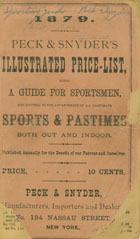 |
| Peck & Snyder’s 1879 Catalog. By 1879, Peck & Snyder’s offerings included a wide range of recreational items, from baseball equipment to accordions to magic tricks. |
|
Since the 1840s, baseball had been evolving rapidly from a game for children to one for gentleman. The grownups soon imposed structure and standardization on the largely improvisational kid’s game. Baseball clubs formed for recreation and exercise, and friendly competition between clubs was soon part of the mix. Following the end of the Civil War, that friendly competition became more intense. Strong rivalries developed between local base ball clubs, and gradually playing for sport was replaced by playing to win. Clubs began to recruit better players. They cast nets that extended well beyond their communities and quietly offered top players various enticements to play, including jobs and cash. The best ball players gained a celebrity status and came to be known far and wide. Newspapers covered their exploits, fanning the flames of “base ball fever” across the country. The spread of railroads allowed clubs to play games farther away from home.
So the stage was set for the 1869 Cincinnati Red Stockings.
The Cincinnati Red Stockings are one of legendary teams of baseball. Harry Wright, a player on several New York clubs before the Civil War, saw the business opportunity in baseball as a spectator sport. In 1869, Wright built a club around a nucleus of himself, his brother George, and several other strong players from teams from the eastern United States. Backed by Cincinnati investors, the Red Stockings are considered to be the first openly professional baseball team. Taking advantage of the opening of the first transcontinental railroad in 1869, the Red Stockings embarked on a coast-to-coast national tour, covering 12,000 miles, and playing before over 200,000 spectators. They were unbeaten in over 70 games over two seasons, finally losing to the Brooklyn Atlantics in June 1870.
The exploits of the Red Stockings did much to popularize baseball around the nation and demonstrated that professional baseball teams could be an economic success. The Red Stockings lasted only five years (1866-1871), but Harry and George Wright went on to form the Boston Red Stockings (which eventually became the Boston-Milwaukee-Atlanta Braves). Major League Baseball marks its start with the Red Stockings and their national tour of 1869. Harry and George Wright are in the Baseball Hall of Fame.
Peck & Snyder was Manhattan’s first sporting goods store. It was founded by Andrew Peck, who got his start in 1865 making baseballs. Peck & Snyder is credited with starting the first baseball card series when they pasted advertisements for their store on the back of team photographs, including the Cincinnati Red Stockings, the Chicago White Stockings, the Boston Lowells, the Brooklyn Atlantics, the New York Mutuals and the Philadelphia Athletics. Along with brewers, hotel keepers and transit companies, sporting goods makers knew that baseball was good for business.
So, in this card, we can see the emergence of baseball as a true national pastime--and as a business. Here was a New York store, creating a trade card with a Cincinnati team on it. This Cincinnati Red Stockings card was important enough that it was framed by its owner--reflecting the celebrity status of the players and, perhaps, the rooting interests of its owner.
|

